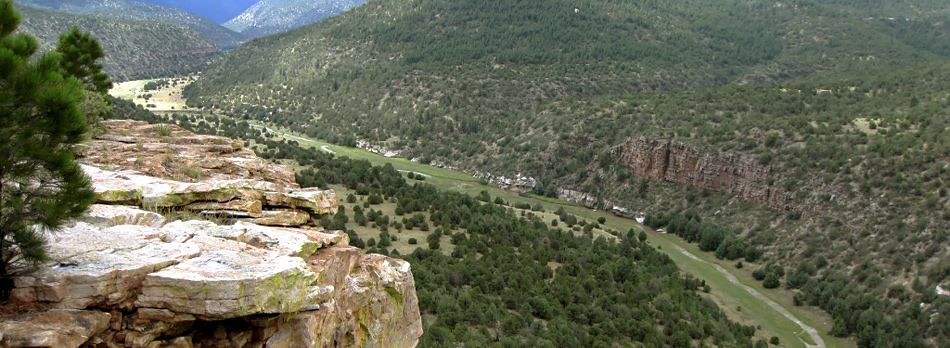
Driving again about 10 miles off the highway, I arrived at the turn leading to the highest elevation of a very large plateau surrounded by mountains, which appeared to be anywhere from 15 to 20 miles away. I had arrived at the Visitors Center at the Las Vegas Wildlife Refuge. A sign on the door read, “Rangers not here, required to be in the field.” However, one ranger was there, and we spoke briefly as she was leaving.
Before getting into her car she remarked, “Look over there at the smoke coming up over the farm mountain. It’s been burning for three days.”
My mind quickly focused on the numerous fires in California and a recent one at Glacier National Park, where they were forced to close part of the park. Fire has always been a natural experience in the forests of the world. Olmsted did not understand the creative work that fires do. He proposed ideas that would provide viewing places and protect the giant trees from fire around the Mariposa Big Tree Grove (Sequoias). However, scientists now understand that fire helps to free seeds and give them a fertile place to be and germinate. The ways of Nature are not always Humanities ways.
With the Visitors Center locked, I decided to take a walk around the trail that circled the small building, simply a speck in this wonderful, expansive scenery. Clouds had been gathering throughout the afternoon and now thunderheads appeared in all directions, and in the distance, the grey skies indicated rain was falling and getting closer. My attention was focused on the bird life and butterflies, which were taking advantage of the many attractive wildflowers. In a distant pond, there were many ducks and geese, and through my binoculars, a majestic great blue heron.
Suddenly, I heard thunder coming from three directions, as I stood on top of this broad plateau with a 360 degree perfected view of the skies above, all the way down to the mountaintops. Such an image. But it was real. The thunder seemed to be coming from all directions. The skies darkened. The gray areas indicating heavy rain seemed to be converging. This must be illusion. Storms would not move toward a specific point. My pace of walk picked up, as I headed back to the Visitors Center and the car. The rain started, increasing steadily. Arriving at the front door of the Visitors Center, the sign was gone, and the door was open.
I walked in and gave a call of greeting, “Hello! Anyone here?”
It seemed rather a dumb call in the midst of the growing storm outside. However, a man entered the display room, which was very attractive and eye catching.
“Hi, I’m Gerry and have been enjoying your wonderful refuge. I had seen a brilliantly colored bird which had an entirely bright red breast and underside, with black around the head, and a back with white on the wings.”
“Could have been a grosbeak, but they are usually down in the woods.”
Perhaps it was a grosbeak, and Philip got out a bird book. I said “That’s the one, black headed grosbeak.” In the East, we have the rose breasted grosbeaks with bright rose colored throats. Both birds are a dramatic sight in the wild.
Philip Garcia had introduced himself as a long-time member of the Department of Interior’s ‘Fish and Game Division.’ We talked a long time about the many federal agencies located in the Department of Interior and Department of Agriculture. So very, many agencies at the National, State, City, and Local levels have responsibility for the natural resources of America. And in every one, there appears to be a serious under-funding. Plus, the interactions between various levels of government authorities can be complicated. And then we must add the vast number of private non-profit groups, which enter into the picture, with their individual agendas, and the challenges grow. Yet, out here in the midst of the wide open spaces, with the glory of purple mountain majesty, and crowned with sisterhoods and brotherhoods and people at times, all working together, a great hope filled my mind, heart, and spirit.
Philip and I talked a great deal about his background: Spanish, Indian and Mexican. He had worked in many places around the nation, always finding the work exciting and challenging. A certain rooted conviction about nature’s beauty and power gripped me. Philip had returned to his homeland after 20 years and settled down. Now with a wife and two children, a boy and girl, he is rooted in this incredible wide-open, free, spacious, mystical and magical environment of the New Mexico.
Again, the trials and tribulations in the living of these days is almost to the breaking point, where reason seems to be a rare commodity in a world in which we are all focused on our own self-centered beliefs and actions. However, with the people here in New Mexico, and in other places, there are still small voices that say each of us still have a chance.
Good to hear from you, Mr. Olmsted. I was beginning to wonder where you were and when you will return to JP with so many stories/observations to share. BSG
LikeLike
Sounds and looks like you are having a great time Gerry. Look forward to seeing you on your return. Peter ad I enjoying Maine but no Black-headed grosbeaks here.
Marygrace and Peter
LikeLike
Come back, Fred. There’s this park in Brooklyn…
C. Vaux.
LikeLike
YEA Alan! Love it ! BSG
LikeLike